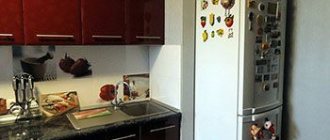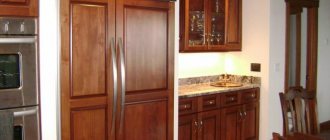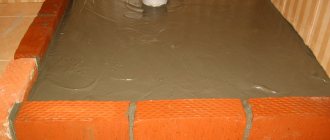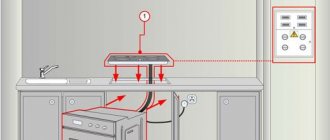Why shouldn't you place the refrigerator next to the stove?
There are a lot of arguments against it, ranging from the usual loss of comfort to premature failure of the refrigerator. Moreover, we draw your attention to the fact that there is no difference whether you place the refrigerator next to a gas stove or an electric one. Their sides heat up equally, especially if we are talking about a working oven. But, let's take it in order.
The heat from the stove makes the refrigerator work at its limit.
Some people think that proximity to a hot stove can lead to the fact that the refrigerator compartment will not cool very well, and that’s all. Or rather, temporarily warm up from the heat. That is, it’s worth revving up a little and the problem will be solved.
But it's not that simple. It's just the opposite. The warmer it is around, the more intensely the compressor generates cold... And the optimal temperature in the refrigerator will not drop, no. But this state of affairs is not at all useful for the technology itself.
The refrigerator is designed to automatically turn on the compressor at certain intervals. But when the outside temperature rises, the compressor is simply forced to work hard to maintain the desired temperature.
Naturally, the service life of the equipment in this case is reduced many times over. Especially if you have a large family and the stove runs very often. Heat the same kettle five times a day, cook some soup, heat up some dish...
And, even if you just fried eggs, the side of the stove does not heat up and cool down as quickly as it seems. The heat, accordingly, first reaches the adjacent side of the refrigerator and maintains an elevated temperature for a long time.
And the compressor turns on and on, without breaks for lunch and dinner. And even without smoking breaks.
However, this is all written in the instructions for the refrigerator. But, if you don’t believe it, you can ask any workshop and the specialist’s answer will be unequivocal: you shouldn’t do that.
Although, if you are so rich that you change refrigerators like gloves, then why not? The compressor will “fly” in five years (or even a little earlier) - buy new equipment, and that’s the end of it.
Rules for the location of the refrigerator and stove
It is recommended to place household appliances in the kitchen according to the “ triangle rule ”. That is, the refrigerator, sink and stove should be located as if in the corners of an isosceles triangle. The optimal distance between zones is from 1.2-2.7 m. Then the devices will not interfere with each other and it will be convenient for the housewife to get food and cook.
Unfortunately, kitchens are often small in size and appliances have to be placed almost end-to-end. Next, we will look in more detail at whether it is possible to place a refrigerator near a gas stove and whether there are generally accepted requirements for placement.
In the layout of many apartments, no more than 5-6 square meters are allocated for kitchen arrangement. m. In such conditions, it is not always possible to place a refrigerator and stove according to the recommended rules
Distance standards between household appliances
All refrigerators differ in power, type of freezing and degree of thermal insulation. Manufacturers must indicate in the instructions the recommended distance for installing equipment from the gas stove. For example, a Zanussi brand refrigerator is mounted from a gas stove at a distance of 50 cm.
If the instructions are lost, then, according to regulations, the minimum distance from any refrigerator to a household gas stove should be 25 cm or more. Ideally, you need to place a table between the equipment.
Bosch refrigerators have multi-layer thermal insulation. They can be installed at a distance of 30 cm from a stove with gas burners and 3 cm from an electric hob
You can install a small cabinet between the refrigerator and the gas stove. Pots won’t fit in it, but it’s convenient to store small things in the form of sponges, various brushes and household chemicals.
Due to the fact that many furniture companies produce cabinet furniture to order, you can easily “disguise” the recommended gap of 25 cm. Thus, they make storage sections or the same cabinets according to individual sizes.
We also recommend that you familiarize yourself with the rules for placing a refrigerator near a gas pipe.
Consequences of close proximity
The gas stove does not have insulation, so during its operation, nearby surfaces heat up.
If the wall of the refrigerator heats up, it will not defrost, it will not work worse, and the food in it will not spoil. However, the compressor of the unit will turn on more often and work for wear . Such a load will negatively affect the service life of the device.
Disadvantages of close proximity of the stove and refrigerator:
- rapid formation of ice inside the refrigerator - due to heating, the compressor begins to cool more intensely, as a result, the ice freezes faster;
- frequent washing of the walls of the refrigeration appliance - during cooking, splashes of fat may fly away, which are subsequently difficult to remove from the metal surface;
- heating deteriorates the appearance of the refrigerator - the paint swells and turns yellow, plastic handles crack or melt, as well as door frames;
- end of warranty - many manufacturers write in the instructions that the refrigerator should not be installed near a stove, oven or heating appliances; even the minimum permissible distance between household appliances is indicated;
- increased energy consumption - the compressor often turns on and the device operates at full power.
In addition, if the refrigerator is located right next to each other, then it is not very comfortable to use a gas stove, since you can only approach the hob from one side.
With the stove and refrigerator close together, there is almost no free space left. This is not practical, since the handles of frying pans and other utensils will rest against the wall of the refrigeration unit
If you still have to place household kitchen appliances nearby, then you need to take care of additional thermal insulation of the refrigerator wall.
Electricity bills
And not only are you simply “killing” the motor of your refrigerator, you are also regularly overpaying for light. The refrigerator already drags a lot without this, but if you force it to work 5-6 times more intensely, you yourself understand how much money it will cost.
After all, in order to cool the chamber, the refrigerator needs electricity to “jerk”. So think about whether it is beneficial to arrange kitchen elements this way. But, if you are rich, this argument will not convince you. Then maybe the next one will seem sane?
Distance between free-standing devices
The distance between the refrigerator or freezer and any heat sources, which includes the oven, is indicated in the instruction manual and is 50 cm.
If the refrigerator breaks down due to the proximity of the heating device, the service center will refuse warranty repairs.
Reference! Some refrigerators with the Full NoFrost system require a distance of at least 5 cm on each side from any furniture and appliances. This location feature is due to the fact that condensers are located in the side walls, so air circulation is necessary to avoid overheating. Installation requirements are necessarily indicated in the instructions and cannot be ignored.
In practice, it is not always possible to place devices so that there is a distance of half a meter between them. If you use modern technology: an induction hob, a reliable electric oven with a tight-fitting door, the distance can be reduced to 15 cm. A narrow kitchen cabinet can be squeezed into this gap to economically use precious space.
Prolonged operation of the stove can heat the air, and only on one side of the refrigerator. In an effort to equalize the temperature, the compressor will run without shutting down. As a result, food in the opposite half of the refrigerator may freeze. Forced ventilation above the stove will help avoid this. Using a hood will minimize the heating of the air near the stove.
Important! The distance to the gas stove must not be reduced!
Food spoilage
Such “swings” are not in vain for the internal microclimate of the refrigerator chamber. There is no stability of cooling, you understand, therefore, there is no way to maintain an even temperature.
And as a result, sometimes the food will simply freeze. This is especially bad for fresh vegetables, fruits, and herbs. After a bunch of parsley is covered with a thin crust of ice, the smell will almost disappear and there will be almost no taste left.
Also, red caviar really doesn’t like freezing. It tastes completely different and becomes deformed.
Of course, this will not happen right away, but after a couple of years of operation of the equipment in a similar mode. And further! The freezer will also become covered with ice. And you will have to clean it much more often than under normal conditions.
Built-in appliances in the kitchen
Not a bad option for a small kitchen. The built-in appliances are compact and can be hidden behind the facades so that the room has the same style. Ovens of modern production are reliably protected and have thermal insulation. It allows you not to release heat into the environment. In addition, built-in ovens are equipped with a fan and an automatic shutdown system if overheating does occur. Such household appliances are safe for people and for surrounding household appliances.
Or you can do the opposite and install a built-in refrigerator. External finishing is not only responsible for the aesthetic appearance, but also provides good thermal insulation. This refrigerator can be placed anywhere in the kitchen. The proximity of an oven, stove or radiator is not scary for him. Video: Mistakes that must be avoided when designing and arranging a kitchen
Show more articles from the category - Household Appliances
Difficulty in dealing with greasy drops on the walls of the refrigerator
Another minus. At first it seems: what’s wrong with that? I’ll cook it and immediately wipe off the splashes. But, as always happens, you immediately become too lazy to wipe it off, the drops dry up tightly, and then look ugly against the backdrop of the snow-white side of the refrigerator...
But getting rid of them is now not so easy, because the delicate enamel of the refrigerator is not like a ceramic “apron” on the wall, and it will not withstand friction with an iron brush.
In general, you will have to keep an eye on this matter all the time and do not forget to wipe it right away. And this is no longer good, it’s annoying.
Of course, if you have absolutely no other way to place the elements, then we will tell you how to protect the refrigerator from grease. But, nevertheless, we insist that you think carefully again.
Arrangement of kitchen appliances
In a standard kitchen, as a rule, it is necessary to place:
- stove with oven (or separate hob and oven);
- washing;
- fridge;
- table top;
- shelves and cabinets for storing dishes and food;
- dining area, if space allows.
When arranging all these elements in the kitchen, you need to take several parameters into account:
- Interior. The appearance of furniture and equipment should be harmonious and proportional. There should be no unnecessary details, especially in a small space. This not only visually clutters the kitchen, but sometimes also physically interferes.
- Ergonomics. The work area should be comfortable. The refrigerator, sink and stove with oven should not be at different ends of the room. Ideally, the distance should be such that you can easily reach what you need from the working surface. If the kitchen is large, you can separate the dining set and the kitchen set into different corners.
- Rules for operating equipment. The refrigerator should not be placed next to the oven or hob. It should be away from the battery.
More information about installing a household refrigerator next to a heating radiator - https://holodilnik1.ru/holodilnoe-oborudovanie/mozhno-li-stavit-bytovoj-holodilnik-rjadom-s-batareej-otoplenija/
If the kitchen is spacious, there will be no problems with placing all the equipment and furniture. Corner, L-shaped and U-shaped design of the work area is perfect. If the dimensions allow, you can move both the oven and the stove to a separate island with a countertop and sink. The refrigerator in this case is located against the wall opposite.
In small spaces you have to think through everything very carefully. It’s good if there is a niche in the kitchen layout, the refrigerator can be placed there. If the room is very tiny, sometimes there is nothing else left but to move the refrigerator into the hallway. Not everyone is happy with this approach. If you can’t make the distance between the refrigerator and oven at least 50 cm, you should think about protective screens or built-in appliances.
How to isolate equipment from each other?
So, what to do if it is not possible to space the refrigerator and oven away from each other:
- Install a narrow cabinet between the appliances if there is at least some free space.
- Place the refrigerator in the box. It will protect equipment not only from overheating, but also from splashes of grease.
- Use a powerful hood. It traps hot air, and the refrigerator does not get as hot from the oven.
- Buy compact versions of household appliances. This will help save space and finally give you valuable centimeters to install the refrigerator and oven at a distance from each other. Small-sized equipment is a solution for those who live alone or together.
- Choose a narrow refrigerator model (up to 55 cm). Even a small distance saved can be enough to prevent devices from interfering with each other.
- Choose an oven with a cooling system and thick glass in the door.
- Surprise everyone and place the oven above the refrigerator. This method is good if the refrigerator compartment is small, otherwise it will be very inconvenient to use the oven.
Important! In Khrushchev-era apartments, the wall between the kitchen and living room is not load-bearing, so you can move it a little and place a refrigerator in the resulting niche.
Materials for thermal insulation
If you can’t carve out even a little space, you need insulation. Whatever material is chosen for it, it is worth thinking about the aesthetic component. It is better to paint the outer side of the screen to match the color of the refrigerator or the trim, hide it with a decorative film, or cover it with a profile of a suitable color and texture.
You should not attach the insulation tightly; in most cases, double-sided tape is sufficient. If necessary, the protective screen can be removed at any time and the refrigerator wall can be cleaned of glue residues. The insulation must be attached to the refrigerator, and not to the oven, otherwise the tape will quickly peel off due to exposure to high temperatures. Insulation options:
- Chipboard. One of the simplest and most affordable ways to insulate a refrigerator. It is enough to place a sheet of chipboard between it and the oven or stove. The side cut can be hidden using decorative adhesive tape; this service can be ordered at the same place where the sheets are cut. Ideally, the screen should be the same color as the furniture in the kitchen, or blend in with the refrigerator. In the case of chipboard, this problem is very easy to solve - you can use paint or PVC film. This screen has only one drawback, its fragility. After 2 - 3 years the sheet will have to be replaced with a new one, but it is so cheap that this is unlikely to be a problem.
- Tiled screen. It looks unusual and original; in addition, the tiles are easy to clean and are not afraid of high temperatures. The tiles are attached to an OSB sheet or to thick drywall. Such a screen can become an extension of the kitchen apron. It is important to take care of the grout and its waterproofing, so it will retain its qualities longer, and moisture and grease will not get onto the base.
- Triple protection made of glass, foil or mirror. Foil reflects heat perfectly, just like a mirror surface. If the reflection in the mirror is not satisfactory, you can cover it with a frosted glass panel. It is worth choosing tempered glass, it can withstand loads. If such a screen still manages to be broken, it will not crumble into sharp fragments, but will disintegrate into small pieces with blunt edges. This type of protection is the most expensive of those listed, but it is very effective.
- Plain foil. Simply glue a sheet of foil onto the same chipboard or drywall. Such a screen will reflect heat from the oven and other appliances.
As a rule, this is quite enough to protect the refrigerator from overheating. The device will operate in normal mode, which means it will not consume excess electricity and will not wear out faster than expected.
And finally: Feng Shui is against it!
For a snack of all the minuses - here's the opinion of Feng Shui. For some reason, the refrigerator is considered an object that personifies the element of Water. But the stove is Fire. And these two things do not get along with each other, which means they bring a negative aura into the house, thicken the climate of your apartment and fill it with alarming fluctuations...
So, if there is a quarrel in your house, know: it’s all to blame for the refrigerator, which you, without thinking, placed next to the stove.
More protection, less risks
If you place the refrigerator close to the gas stove, problems cannot be avoided. While cooking, it will heat up its “neighbor”. The device will begin to cool unevenly, causing wear and tear. Electricity consumption will increase significantly, and the service life of the refrigerator will be reduced. The wall next to the stove will become covered with a layer of greasy and oily droplets.
Manufacturers recommend leaving at least 50 cm between the stove and the refrigerator. Separate them with a custom kitchen cabinet or cabinet. They will protect household appliances from heating and become additional places for storing food and utensils.
Attention! The greater the distance from the stove to the refrigerator, the less harmful the effect on it.
If there is no other option, make a partition between the “neighbors” from plasterboard or aerated concrete. To make it fit into the interior, decorate it to your liking. Tempered glass is suitable for a protective wall.
What are the alternatives for placing a refrigerator?
If you are deeply moved by our beliefs, then you need to abandon this idea and look for another place for the refrigerator.
Unfortunately, we don’t know your layout, but for some reason we assume that your kitchenette is very small, which means, most likely, you are the owner of a Khrushchev-era apartment.
So, if this is the case, then it really is bad. There are no adjacent storage rooms in a niche in which you can put a refrigerator, nor a balcony that can be combined with the kitchen and take equipment there.
But on the other hand, there is a wonderful advantage in Khrushchev apartments - the interior partitions there are not concrete or load-bearing. Therefore, if your refrigerator does not fit on the opposite wall, then you can simply make a small opening in the wall between the kitchen and living room and build a niche from it.
This way, the kitchen will remain uncluttered, the refrigerator door will be flush with the wall, but a washing machine can be installed in its place. This, after all, is also the problem of Khrushchev apartments, with their two-meter bathtubs.
And the fact that in the living room the wall will not be flat, but with a difference, is even interesting. You can decorate the ledge in any way you like, hang pictures or shelves on it.
Also: when looking for another place for the refrigerator, do not forget that it is not recommended to place it not only next to the stove, but also to the radiator. It will be the same, or even worse. Heating in this case is seasonal, but continuous for many months.
The same goes for the gas pipe. It gets warm, which means it is a bad neighbor for the refrigerator and it has no place near it.
What can be used as insulation?
In cases where finances do not allow you to install appliances, or there is no such need, you can independently isolate the oven from the refrigerator. For these purposes, special cardboard, foil, wood and glass panels are used. The construction market sells a huge variety of heat-resistant materials that can extend the life of refrigeration equipment next to the oven.
Many thermal insulation options look quite aesthetically pleasing. For example, foil wrap looks good on steel and white refrigerator models, while wood paneling can be made from the same material as kitchen cabinets. All that remains is to choose the appropriate option and apply it in practice.
Furniture partition
The refrigerator can be placed next to the oven by separating the appliances with a furniture partition. The partition can be made to match the height of the refrigerator or oven. It can be ordered from the factory where the kitchen corner of the owners of a small kitchen was produced. Wood has both thermal conductivity and insulating properties.
The partition method is simple and cheap to implement. When the devices are close to each other, the partition does not even need to be fixed; just insert it between the units and move them close. The width of such a partition can vary from 5 cm or more. Height depends on personal preference.
Heat Reflective Foil
The oven and refrigeration equipment can be installed most tightly using heat-reflecting foil. Izolon included in the film will not allow heat to pass from the oven to the refrigerator. The foil surface will simply reflect thermal radiation, making heating of the refrigerator wall minimal.
This method of thermal insulation is suitable for almost any kitchen interior. This option looks especially good in rooms in high-tech, futurism, and classic styles. Heat-reflecting foil not only copes well with the task assigned to it, but also saves space due to its thin and light layer.
Thermal insulation cardboard
Basalt cardboard can be regular or foil. The material is made from the same composition as mineral wool. This cardboard is ultra-thin, but has good thermal insulation characteristics. The low degree of thermal conductivity of one sheet can withstand up to 2 thousand heating cycles. This cardboard can be glued to the refrigerator with inorganic glue. The fireproof qualities of the material are also excellent.
This cardboard does not absorb moisture from the air, which is very important, because it is used in the kitchen. This material can protect the walls of the refrigerator from overheating, both from the oven and from the heating appliances. Screens and substrates for cooling and heating elements are made from basalt cardboard. In the field of thermal insulation, the material is considered a universal and reliable barrier between units with different properties.
How to minimize the risk of proximity between a stove and a refrigerator?
If you have reached this block, then you are definitely not impressed by our “horror stories” and our rationale for moving the refrigerator did not find a response in your soul.
Well, if you really want to put these two things next to each other, then you definitely need to separate them somehow, at least with some small partition. Of course, the thicker the insulation, the better, but rather than nothing at all, a thin piece of some material is still better.
We will give you examples of the most popular options, and you can choose which one you like best.
Before we start looking at thermal insulation using examples, I would like to note this:
There is no point in attaching a shield that will be located between the stove and the refrigerator.
Or rather, fix it “tightly”, for example, with strong glue, such as “liquid nails”, since, who knows, you might someday have a rearrangement and this piece of slab will interfere?
It is best to buy double-sided tape, it holds very firmly and use it to glue the shield to the surface of the refrigerator. Yes, exactly the refrigerator, because the heating side of the stove will simply melt this glue and nothing will stick.
So let's look at protection options.
Ways to protect your refrigerator
When it is not possible to leave the recommended gap between the devices, you need to make your own partition from a material with insulating properties. Both organic and inorganic materials can be used as thermal insulation separating the refrigerator from the gas stove.
Organic options: reeds , cork sheets , textolite , chipboard . These materials are moisture resistant and can be used as insulation. But it is worth remembering that with prolonged heating they can become deformed.
Inorganic heat insulators:
- fiberglass;
- asbestos cardboard;
- isolon;
- mineral wool;
- drywall.
The materials have high heat-insulating properties. The only thing is that they can lose their quality when exposed to moisture, so they are not installed next to the sink.
Thermal insulation materials are sold in the form of rolls or small sheets with a thickness of 5 millimeters or more and a width of 75 centimeters. The insulation is easily cut into strips; before gluing it must be leveled
On one side, the rolled thermal insulation has a self-adhesive surface, and on the other, it is covered with a lavsan film. The material should be glued from top to bottom onto the entire surface of the refrigerator wall.
There is no self-adhesive layer on sheet insulation. It is recommended to use double-sided tape to secure it. It holds sheets well and can be easily removed when it is necessary to replace the material.
Protective screen made of simple chipboard
You can simply buy a piece of laminated chipboard and place it between the stove and the refrigerator. Just do not forget that the side cut will need to be treated with adhesive tape, and this must be ordered at the place where the sheets are cut.
Be sure to choose a sheet to match the kitchen furniture. It would be ideal if it were exactly the same as the main body of the kitchen.
Of course, this shield will not last forever, because chipboard is afraid of hot and moisture, which means that in a few years it may lose its appearance. But such a thing is very inexpensive and we think you won’t go broke if you have to buy another sheet in a couple of years.
Possible consequences of incorrect installation
If you place an oven and refrigeration equipment very close without special insulation, consequences will certainly occur.
You may be interested in: Storing yeast in the refrigerator
The negative impact of excess heat on both devices can be expressed as follows:
- breakdowns due to overheating;
- loss of warranty;
- sparks, short circuits, fire;
- traumatic situations;
- poor food preservation;
- problems with food in the oven;
- damage to wall, floor and ceiling coverings;
- dirt on the refrigerator due to the proximity of the hob.
It is worth remembering that the side wall of refrigeration equipment or freezer is not intended for frequent washing and wiping off grease with aggressive detergents. Due to its proximity to the stove, the refrigerator will quickly lose its neat appearance, freeze poorly, and work intermittently.
The most terrible consequence of the proximity of such units is fire. Two devices consume a lot of electricity, and in conditions of constant overheating they can even melt the sockets to which they are connected.
A fire that occurs for this reason will not be covered by any insurance, not to mention the lives it could take. It is best to play it safe in advance and install the devices in accordance with all safety regulations. Electricity is no joke.
Protective screen with foil, mirror and glass
And this is an absolutely wonderful option. Foil or mirror perfectly reflects heat, and such a partition can be much thinner than other options. The only negative is that the mirror reflection is out of place; it can be removed using corrugated glass placed on top.
This is the most expensive method, but it is also the most effective. The refrigerator will hardly feel any heat from the stove, which means it will serve you faithfully for much longer. In any case, heat reflection is better than simple thermal insulation.
But if you combine these two methods, it will be completely good. That is, put a thick shield and stick foil on top of it.
In conclusion, I would like to say: now you know everything and even more on the topic. But the decision is yours, we just advise and hope that our considerations benefit you.
Instructions for making a protective shield
Shields are used to separate the refrigerator from the gas stove. Thermal insulation can be made from various materials, for example, chipboard. The plates have high rigidity, so they do not need to be glued to the surface of the devices.
Option #1 - thermal insulation with chipboard
A chipboard will help protect the refrigerator from the effects of a gas stove. Install it between household appliances and the stove.
The side cuts of the shield must be covered with adhesive tape. Otherwise, different-sized chips will be visible in the structure. In addition, in places where cuts are not closed, the material is difficult to wash. Therefore, the ends are covered with decorative film or laminated. You can order this service at places where sheets are cut.
It is better to buy laminated chipboard. There are many color options for this material. You can choose the color of the shield that will match the color of the furniture and match the design of the kitchen
On average, thermal insulation made from chipboard lasts for three years. Afterwards, the appearance is lost, as moisture and heat destroy the structure of the material. But since such thermal insulation is inexpensive, it can be changed at least annually.
Option #2 - constructing a shield from tiles
It looks beautiful and is easy to clean – these are the main advantages of a thermal insulation board made of tiles. It fits optimally into the kitchen design, especially if it matches the style and color of the “apron”.
If moisture gets on the drywall, it will begin to deteriorate. Therefore, when laying tiles, carefully cover the cracks.
The tiles are glued to the shield using special glue. You can lay the tiles on a sheet of chipboard, moisture-resistant plasterboard, OSB boards, and also QSB
Option #3 - making a mirror screen
Mirror surfaces reflect heat well. Mirror, glass or foil can be used as the main thermal insulation material. Attach the insulation to the partition using glue.
A partition with foil is thinner than other thermal insulation options. To improve the protective properties, you can glue the material onto a thick shield. Then the mirror screen will be durable and last longer.
A foil screen will be quite expensive. However, it is able to reflect heat better than regular cheap insulation. This means that the refrigerator will not heat up and will last longer.
The only disadvantage of such insulation is mirror reflection, but this can be removed if corrugated glass is placed on top.
Built-in refrigerator
Today, built-in household appliances are very popular. It is convenient, beautiful and practical. If you plan to place a refrigerator built into the kitchen unit in the kitchen, then you can place an oven next to it. Any equipment intended to be built into a set initially requires the presence of an additional thermal insulation layer.
Plus, the niches in the kitchen set in which the appliances will be installed are created according to certain standards. They assume the presence of circulation gaps that ensure the normal functioning of the refrigerator, electric oven and other equipment.
Refrigerator built into the kitchen unit
Placement of built-in devices
The answer to the question about placing a refrigerator and oven next door will be positive if one of these appliances is built-in. Thus, modern built-in ovens are endowed with special heat-protective properties and are additionally equipped with a heat-insulating layer. Which creates a barrier to the spread of heat in the external environment. The same applies to built-in refrigerators that have additional thermal insulation in their external elements. This will also allow you to place the device in close proximity to the oven. But what can be used to create insulation if the placement of these two electrical appliances is unavoidable?
It is necessary to create a distance of at least 15 cm. The following tips will be useful in solving this problem:
- A shelf or cabinet will create the necessary gap between appliances and add additional functionality to the kitchen interior.
- A furniture partition in the form of which you can use a frame for installing household appliances, made of wood. This will protect the devices from unwanted thermal effects.
- Insulating the wall of the refrigerator that is closest to the oven will reduce the risk of excessive heat. To do this, you will need heat-reflecting foil.
Modern household appliances can be installed nearby, but it is worth considering the operating requirements and following safety rules. Based on simple recommendations, placing an oven and refrigerator in the kitchen will not be difficult.











